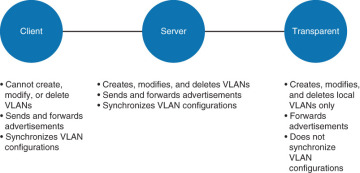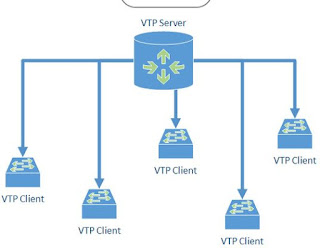VTP Theory
Virtual trunking Protocol (VTP)
VTP (VLAN Trunking Protocol). VTP will let you create VLANs on one switch and all the other switches will synchronize themselves.
(VTP) is a Cisco
proprietary protocol that propagates the definition of Virtual Local
Area Networks (VLAN) on the whole local area network. To do this, VTP carries VLAN information to all the switches in a VTP domain. VTP advertisements can be sent over ISL and 802.1Q,.
We have one VTP server which is the switch where you create and modify or
delete VLANs.
The other switches are VTP clients. We have as well VTP in transparent mode , that forward VTP advertisement but ignore information contained in the message..A transparent switch will not modify it's database when updates are received ,or send out an update about any change of its VLAN status
You can have multiple VTP servers
since it also functions as a VTP client so you can make changes on
multiple switches in your network.To make VTP work you need to
setup a VTP domain name (any name that you want), as
long as you configure it to be the same on all your switches.
This information is important that you remember:

There is another mode, primary server mode..only available on version 3 create, modify and delete VLANs.
The VTP configuration
has a Revision Number which will increase when you make a change. Every
time you make a change on the VTP server this will be synchronized to
the VTP clients.
When you set a VTP Domain Name, the revision number is set to zero, after which each change to the VLAN database increases the revision number by one.
Always check your VTP revision numbers before adding a switch to your
network or when adding a switch back to your network. If you remove a
switch and place it in your lab, you may create additional .VLANs or
delete all configured VLANs — either of which will increase the revision
number.
3 things to do in those scenarios:
A.-check on the vlan.dat
B.-delete that file
C.-set that switch to the network in transparent mode
Requirements for switches to form using VTP to exchange information
The purpose of of VTP version 3 is to synchronize VLANs but it
has a number for extras. It’s been around for a while but until recent
IOS versions it wasn’t supported on Cisco Catalyst Switches.
Here are some of the new additions to VTP version 3:- VTP primary server: Only one primary server is able to create, modify and delete VLANs. This is a great change as you can no longer “accidentally” wipe all VLANs like you could with VTP version 1 or 2.
- Extended VLANs: you can now synchronize VLANs in the extended VLAN range (1006 – 4094).
- RSPAN VLANs: remote SPAN VLANs can now be synchronized
- MST Support: one of the problems of MST is that you had to configure each switch manually. With VTPv3, MST configurations are synchronized.
- Authentication improvements: VTPv3 has more secure methods for authentication.
- VTP mode off: If you didn’t want to use VTP for version 1 or 2 then you had to use the transparent mode. VTPv3 can be disabled globally or per interface.
- Prune off: we can dynamically prune off uneded VLAN
- Compatibility: VTP version 3 is compatible with version 2, not version 1.
- Private VLANs: if you have VLANs that are configured as private VLANs then you can synchronize them with VTPv3.
VTP Theory
 Reviewed by ohhhvictor
on
2:52:00 PM
Rating:
Reviewed by ohhhvictor
on
2:52:00 PM
Rating:
 Reviewed by ohhhvictor
on
2:52:00 PM
Rating:
Reviewed by ohhhvictor
on
2:52:00 PM
Rating:




















No comments: